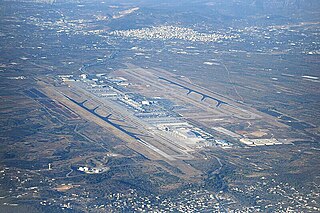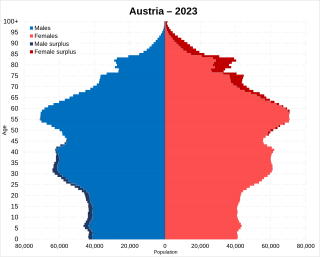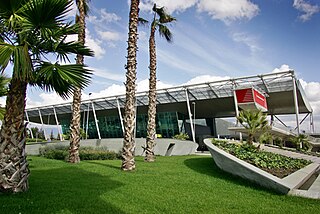At a glance
Graphs are unavailable due to technical issues. Updates on reimplementing the Graph extension, which will be known as the Chart extension, can be found on Phabricator and on MediaWiki.org. |
Austria has six airports that are generally used for passenger traffic. [1] The airports are ranked by the total passengers, with the annual and rank change since the prior year.
Vienna International Airport always ranks first with tens of millions of passengers per year. This is typically followed by Salzburg Airport with around a million or two passengers per year, then Innsbruck Airport (except in 2021), Graz Airport, with Linz Airport getting a few hundred thousand passengers, and Klagenfurt Airport being ranked last.
Graphs are unavailable due to technical issues. Updates on reimplementing the Graph extension, which will be known as the Chart extension, can be found on Phabricator and on MediaWiki.org. |
| Rank | Airport | Total passengers | Annual change | Rank change |
|---|---|---|---|---|
| 1 | Vienna | 23,682,133 | ||
| 2 | Salzburg | 1,229,495 | ||
| 3 | Innsbruck | 721,412 | ||
| 4 | Graz | 561,375 | ||
| 5 | Linz | 207,766 | ||
| 6 | Klagenfurt | 82,760 |
| Rank | Airport | Total passengers | Annual change | Rank change |
|---|---|---|---|---|
| 1 | Vienna | 10,405,815 | ||
| 2 | Salzburg | 299,845 | ||
| 3 | Graz | 226,561 | ||
| 4 | Innsbruck | 125,495 | ||
| 5 | Linz | 68,509 | ||
| 6 | Klagenfurt | 29,577 |
| Rank | Airport | Total passengers | Annual change | Rank change |
|---|---|---|---|---|
| 1 | Vienna | 7,813,743 | ||
| 2 | Salzburg | 669,790 | ||
| 3 | Innsbruck | 487,437 | ||
| 4 | Graz | 199,510 | ||
| 5 | Linz | 51,306 | ||
| 6 | Klagenfurt | 49,395 |
| Rank | Airport | Total passengers | Annual change | Rank change |
|---|---|---|---|---|
| 1 | Vienna | 31,662,189 | ||
| 2 | Salzburg | 1,717,991 | ||
| 3 | Innsbruck | 1,144,471 | ||
| 4 | Graz | 1,036,929 | ||
| 5 | Linz | 436,018 | ||
| 6 | Klagenfurt | 209,278 | ||
| Rank | Airport | Total passengers | Annual change | Rank change |
|---|---|---|---|---|
| 1 | Vienna | 27,037,349 | ||
| 2 | Salzburg | 1,844,362 | ||
| 3 | Innsbruck | 1,119,347 | ||
| 4 | Graz | 1,030,929 | ||
| 5 | Linz | 465,798 | ||
| 6 | Klagenfurt | 228,372 | ||
| Rank | Airport | Total passengers | Annual change | Rank change |
|---|---|---|---|---|
| 1 | Vienna | 24,392,805 | ||
| 2 | Salzburg | 1,890,164 | ||
| 3 | Innsbruck | 1,092,547 | ||
| 4 | Graz | 959,166 | ||
| 5 | Linz | 402,007 | ||
| 6 | Klagenfurt | 216,905 | ||
| Rank | Airport | Total passengers | Annual change | Rank change |
|---|---|---|---|---|
| 1 | Vienna | 22,165,733 | ||
| 2 | Salzburg | 1,819,520 | ||
| 3 | Innsbruck | 991,356 | ||
| 4 | Graz | 897,171 | ||
| 5 | Linz | 561,295 | ||
| 6 | Klagenfurt | 225,842 | ||
| Rank | Airport | Total passengers | Annual change | Rank change |
|---|---|---|---|---|
| 1 | Vienna | 21,999,820 | ||
| 2 | Salzburg | 1,662,834 | ||
| 3 | Innsbruck | 981,118 | ||
| 4 | Graz | 881,565 | ||
| 5 | Linz | 549,961 | ||
| 6 | Klagenfurt | 259,336 | ||
| Rank | Airport | Total passengers | Annual change | Rank change |
|---|---|---|---|---|
| 1 | Vienna | 22,165,733 | ||
| 2 | Salzburg | 1,666,487 | ||
| 3 | Innsbruck | 930,850 | ||
| 4 | Graz | 930,448 | ||
| 5 | Linz | 623,383 | ||
| 6 | Klagenfurt | 280,434 | ||
| Rank | Airport | Total passengers | Annual change | Rank change |
|---|---|---|---|---|
| 1 | Vienna | 21,096,383 | ||
| 2 | Salzburg | 1,700,983 | ||
| 3 | Innsbruck | 997,020 | ||
| 4 | Graz | 976,414 | ||
| 5 | Linz | 679,220 | ||
| 6 | Klagenfurt | 376,198 | ||
| Rank | Airport | Total passengers | Annual change | Rank change |
|---|---|---|---|---|
| 1 | Vienna | 19,682,590 | ||
| 2 | Salzburg | 1,625,842 | ||
| 3 | Innsbruck | 1,033,512 | ||
| 4 | Graz | 989,959 | ||
| 5 | Linz | 692,039 | ||
| 6 | Klagenfurt | 426,935 | ||

Athens International Airport Eleftherios Venizelos, commonly initialised as AIA, is the largest international airport in Greece, serving the city of Athens and region of Attica. It began operation on 28 March 2001 and is the main base of Aegean Airlines, as well as other smaller Greek airlines. It replaced the old Ellinikon International Airport.

The economy of Austria is a highly developed social market economy, with the country being one of the fourteen richest in the world in terms of GDP per capita. Until the 1980s, many of Austria's largest industry firms were nationalised. In recent years, privatisation has reduced state holdings to a level comparable to other European economies. Among OECD nations, Austria has a highly efficient and strong social security system; social expenditure stood at roughly 29.4% of GDP.

Demographic features of the population of Austria include population density, ethnicity, education level, health of the populace, economic status, religious affiliations and other aspects of the population.

Transport in Bangladesh is dominated by roadways, accounting for the majority of both passenger and cargo traffic due to substantial development efforts since independence. Eight major national highways connect the capital, Dhaka, with divisional and district headquarters, port cities, and international routes. Despite this, vehicle usage per capita remains low, with non-motorised modes prevailing. However, Bangladesh's roads are unsafe, having one of the highest road accident fatality rates. They also suffer from high congestion, as well as severe air and noise pollution.

Vienna Airport is an international airport serving Vienna, the capital of Austria. It is located in Schwechat, 18 km (11 mi) southeast of central Vienna and 57 kilometres (35 mi) west of Bratislava, the capital of Slovakia. Its official name according to the Austrian Aeronautical Information Publication is Wien-Schwechat Airport. It is the country's largest airport and serves as the hub for Austrian Airlines as well as a base for low-cost carriers Ryanair and Wizz Air. It is capable of handling wide-body aircraft up to the Airbus A380. The airport features a dense network of European destinations as well as long-haul flights to Asia, North America and Africa.

Copenhagen Airport, Kastrup is an international airport serving Copenhagen, the capital of Denmark, as well as Zealand, the Øresund Region, and southern Sweden including Scania. In 2023 it is the largest airport in the Nordic countries.

Frankfurt Airport, is Germany's main international airport by passenger numbers, located in Frankfurt, Germany's fifth-largest city. Its official name according to the German Aeronautical Information Publication is Frankfurt Main Airport. The airport is operated by Fraport and serves as the main hub for Lufthansa, including Lufthansa City Airlines, Lufthansa CityLine and Lufthansa Cargo as well as Condor and AeroLogic. It covers an area of 2,300 hectares of land and features two passenger terminals with capacity for approximately 65 million passengers per year; four runways; and extensive logistics and maintenance facilities.

Munich Airport is an international airport serving Munich and Upper Bavaria. To the German Aeronautical Information Publication, it is known as Muenchen Airport. It is the second-busiest airport in Germany in terms of passenger traffic after Frankfurt Airport, and the tenth-busiest airport in Europe, handling 47.9 million passengers in 2019. It is the world's 15th-busiest airport in terms of international passenger traffic, and was the 38th-busiest airport worldwide in 2018. It serves as hub for Lufthansa including its subsidiaries Lufthansa CityLine, Lufthansa City Airlines, Air Dolomiti and Eurowings as well as a base for Condor and TUI fly Deutschland.

Tirana International Airport Nënë Tereza, often referred to as the Rinas International Airport, is one of the two main international airports of the Republic of Albania. It serves the city of Tirana, its metropolitan area, and surrounding region in the county of Tirana. The airport is named in honor of the Albanian Roman Catholic nun and missionary, Mother Teresa (1910–1997). It is located 6 nautical miles northwest of Tirana, in the municipality of Krujë, Durrës County.

Luxembourg Airport is the main airport in Luxembourg. Previously called Luxembourg Findel Airport due to its location at Findel, it is Luxembourg's only international airport and is the only airport in the country with a paved runway. It is located 3.25 NM east of Luxembourg City. In 2019, it handled 4.4 million passengers. It is a major cargo airport, ranking as Europe's fifth-busiest by cargo tonnage and the world's 28th-busiest in 2010. Luxair, Luxembourg's flag-carrier, and cargo airline Cargolux have their head offices on the airport property.

Klagenfurt Airport is a primary international airport near Klagenfurt, the sixth-largest city in Austria. It is located in the borough of Annabichl, 1.5 NM north-north-east of the city centre.

Queen Alia International Airport is an international airport located in Zizya, 30 kilometers south of Amman, the capital and largest city of Jordan. It is the largest airport in the country, named after Queen Alia, who died in a helicopter crash in 1977. The airport is home to the country's flag carrier, Royal Jordanian, and serves as a hub for Jordan Aviation.

Soekarno–Hatta International Airport, abbreviated SHIA or Soetta, formerly legally called Jakarta Cengkareng Airport is the primary airport serving the Jakarta metropolitan area on the island of Java in Indonesia. Named after the first president and vice-president of Indonesia, Sukarno (1901–1970) and Mohammad Hatta (1902–1980), the airport is located at Benda, Tangerang and Cengkareng, West Jakarta, which is about 20 km northwest of Central Jakarta.

Nuremberg Airport is an international airport of the Franconian metropolitan area of Nuremberg and the second-busiest airport in Bavaria after Munich Airport. The year 2018, with 4.5 million, was the year with the highest passenger volume to date at this airport. It is Germany's 9th busiest airport in 2022. It is located approximately 5 km north of Nuremberg's city centre and offers flights within Germany as well as to European metropolitan and leisure destinations, especially along the Mediterranean Sea, on the Canary Islands, in Turkey and in Egypt. The Airport is owned and operated by Flughafen Nürnberg GmbH, in turn owned 50% by the state of Bavaria and 50% by the city of Nuremberg.

Innsbruck Airport, also known locally as Kranebitten Airport, is the largest international airport in Tyrol in western Austria. It is located approximately 4 kilometres from the centre of Innsbruck.

Salzburg Airport, branded as Salzburg Airport W. A. Mozart, is Austria's second largest airport. It serves Salzburg, the fourth-largest Austrian city, and is a gateway to Austria's numerous ski areas. The airport is located 1.7 NM west-south-west of the Salzburg City centre and 2 km (1.2 mi) from the Austrian-German border. It is jointly owned by Salzburg Municipality (25%) and Salzburg State (75%). The airport is named after the Austrian composer Wolfgang Amadeus Mozart.

Linz Airport is a minor international airport located in Hörsching, near Linz, the third-largest city in Austria. It was also known as the Blue Danube Airport until 2019.

Chaudhary Charan Singh International Airport is an international airport serving Lucknow, the capital of the Indian state of Uttar Pradesh. It is located in Amausi, 14 km (8.7 mi) from the city centre, and was earlier known as ''Amausi Airport''. It is named after Chaudhary Charan Singh, the fifth Prime Minister of India. It is owned and operated by the Lucknow International Airport Limited (LIAL), a public–private consortium led by Adani Group.